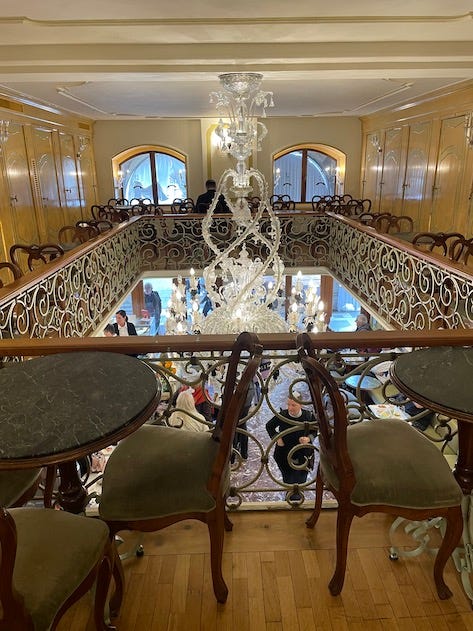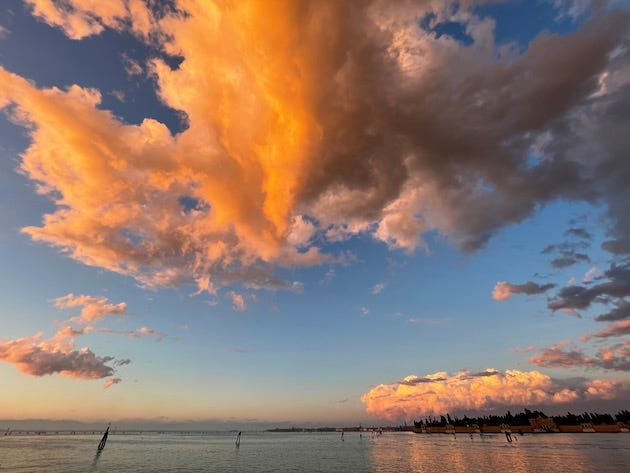Quote of the week
“In Campo San Casiano, because he felt no need to hurry, he decided to have a look at the Tintoretto Crucifixion. Brunetti had always been struck by how bored this Christ looked, stuck artfully up there on his cross, posed in front of the hedge of perpendicular spears that divided the painting in half. Christ seemed finally to have come to accept the truth of those warnings that all this business about becoming human would come to no good; He seemed eager to get back to the job of being God.”
― Donna Leon, The Girl of His Dreams
Hello,
This week I will linger a little bit more in Venice. I am still thinking of our visit almost every day. So much to see and so much to digest. This week I will take you to the marvellous Scuola Grande di San Rocco and the life work of Tintoretto, as well as some culinary tips. I was happy to find a quote about Tintoretto by Donna Leon from her book The Girl of His Dreams. I am presently reading her Commissario Brunetti books which take place in Venice. I have not yet come to this one. I have just finished the 9th book, out of 32.
La Scuola Grande di San Rocco
This specific Scuola was founded in the 15th century. It was just by chance we came upon it, and what we saw inside was astonishing. The Church of San Rocco is situated next to the Scuola, and has housed the body of San Rocco since 1485. He is the protector against the outbreaks of the plague, which was a recurring disease in those days.
In the 16th century, when the Scuola building was ready, a competition to decorate the building was announced, and among several artists Jacopo Robusta, known as Tintoretto, won. He spent 24 years to create the paintings we see today. It is amazing to see the Sala Capitolare with its decorations, marvellous floors, and, above all, the paintings. In a way it feels unreal to walk around this magnificent room. His master piece The Crucifixion was unfortunately closed for restoration. I am sorry that the photos will not show the magnificence of the place.
To eat and drink in Venice
To eat
Where in the world is it best to eat? I think it has to be in Italy. We visited a few different restaurants and everything was good. Maybe it depends on the interior and friendly staff? The first evening we visited a restaurant that Martin found a recommendation for; Trattoria Rivetta. Wonderful family restaurant down by one of the canals near St. Mark's Square. We had to wait half an hour to get a table, but it was worth it.
The second evening we found a small restaurant in a back street, also recommended, Cà D'oro alla Vedova. When it was closed, it didn't even look like a restaurant, just a big wooden door. It is also a popular restaurant, but we had learned the trick of booking a table in advance. A simple, but very nice restaurant, that quickly became full.
The rest of the time we slipped into places when we felt like it. The museum restaurants/cafes also have a good selection of food and beautiful surroundings.
To drink
Even when it comes to drinks, you can find the best in Italy, whether it's a cappuccino, espresso, prosecco or a glass of wine. We visited two bars/cafes around St. Mark's Square, Caffé Florian and Caffé Lavena. Old, beautiful cafes which famous guests frequented in the old days.
At Caffé Lavena, Richard Wagner used to drop in every day when he lived in Venice. He took a cup of tea or a cognac upstairs where a table was reserved for him. There he sat looking out over the piazza. Either he was talking to the owner and creator of the café, Carlo Lavena, or he was accompanied by his wife, Cosima and his daughters. Or by his father-in-law Franz Liszt when he was visiting. Tables and chairs are preserved in the cafe, although when we asked if we could look at them, they said they were being restored.
Wagner enjoyed solitude and rarely mingled with all the people who visited the cafe. According to Wagner's biographer, he composed parts of Parsifal here, as well as a duet between Tristan and Isolde. It is said that even Liszt was inspired to compose some of his most beautiful piano pieces here.
During his first stay in Venice in August 1858, Wagner wrote to Liszt:
“Life in big cities has become completely unbearable for me, mainly because of the din of carriages that infuriates me. Now everyone knows that Venice is the calmest city, I mean the quietest city in the world and that is why I have decided it is absolutely the place for me.”
And, here we sat and soaked up the atmosphere of the great composers and musicians who visited the place. In addition to this, a nice view of St. Mark's Square.
The last evening we went off the beaten track and ended up in the Canareggio district in Venice. There was a boat stop and conveniently also a bar/ristorante, Bar Cupido Venezia. We had a very good pizza, and I finally got to try out a Bellini drink. Coming out we had the most magnificent view of the Island of San Michele, which houses a big cemetery. Igor Stravinskij is buried there among other people. I let the pictures speak for themselves.
On the way back to the hotel, in a small alley (I am not sure I would find my way back) we found Osteria Antica Adelaide (Cannaregio, 3728). Just a ‘hole in the wall’ from the outside, and so beautiful inside we hade to take a night-cap. Next time we visit Venice we have to go there to eat. Hopefully, will find our way back.
Another thing that struck me is that ca. 80% of people taking a drink in a bar, on a terrace or ristorante drink an Aperol Spritz. Much be the most popular drink in Venice. It looks really good in the sun with its orange colour.
Musings this week
Just a small note on the last season of the excellent Netflix TV-series The Last Kingdom. The series is based on Bernard Cornwell’s Saxon Chronicles. One of the best series if you ask me, with excellent actors as well as fantastic filming and locations. I just watched Seven Kings Must Die, the film that ends the saga . Fighting to the very end, our hero, Lord Uhtred of Bebbanburg, held his sword high all through the series that depicts the story and effort of various kingdoms to unite under one king. The story starts during the reign of Alfred the Great in the 9th century and his fight against attacking Danes. The series ends with the Battle of Brunanburh in 937. It seems that this battle holds a significant role in the history of England. In the Anglo-Saxon Chronicle there is a poem called Battle of Brunanburgh where it says: “"never yet as many people killed before this with sword's edge ... since the east Angles and Saxons came up over the broad sea". It was a magnificently staged battle. I always wonder how they are able to film such scenes. Needless to say, Lord Uhtred of Bebbanburg was there to make a last stand.
I very much liked the ending of the story of Lord Uhtred, his family, friends and enemies. It is sad to say good bye to people you seem to know, but all stories come to an end. If you have not yet seen this show, you are lucky to have it all ahead of you.
On my blog this week
So far just one post this week.

















Thanks for the recommendation of The Last Kingdom. I wasn't at all familiar with it and will look it up. Loved this post -- I think no one does opulence better than the Italians, especially of that period. And I'm not sure anyone does food better than the Italians, either! So this was a most "delicious" post in every way!